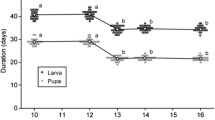Abstract
It is commonly believed that the marked seasonally of temperate regions results in the insects that live there often having discrete generations, whereas in the tropics, generations are more likely to overlap because of the more-or-less continuously favourable conditions. These sweeping generalizations, however, are misleading. Several examples are now known of tropical insect populations that tend to show discrete generations, both under equilibrium1–5 (Fig. la) and non-equilibrium conditions6–9, which are not seasonally determined. We are also struck by the frequency with which laboratory insect populations cultured under constant conditions show discrete generations10–12 (Fig. 1b). A common factor in these examples is the presence of insect parasitoids as a major mortality factor. Here we demonstrate, using theoretical population models, one way in which parasitism can be the cause of approximately discrete generations. In particular, we show that the ratio of the lengths of the host and parasitoid life cycles is of prime importance in determining whether generations tend to be discrete or continuous and discuss the importance of this in biological control.
Similar content being viewed by others
References
1. Bigger, M. Nature 259, 207–209 (1976). 2. Taylor, T. H. C. The Biological Control of an Insect in Fiji (Imperial Institute of Entomology, London, 1937). 3. Metcalfe, J. R. Bull. ent. Res. 60, 565–597 (1971). 4. Notley, F. B. Bull. ent. Res. 46, 899–899 (1955). 5. Banerjee, B. Bull. ent. Res. 69, 195–201 (1979). 6. Tothill, J. D., Taylor, T. H. C. & Paine, R. W. The Coconut Moth in Fiji (Imperial Institute of Entomology, London, 1930). 7. Van der Vecht, J. Ent. Ber. Amst. 15, 122–132 (1954). 8. Wood, B. J. Pests of Oil Palms in Malaysia and Their Control (Incorporated Society of Planters, Kuala Lumpur, 1968). 9. Perera, P. A. C. R. thesis, Univ. London (1987). 10. Utida, S. Ecology 38, 442–449 (1957). 11. Hassell, M. P. & Huffaker, C. B. Res. Popn Biol. 11, 186–210 (1969). 12. White, E. G. & Huffaker, C. B. Res. Popn Biol. 11, 150–185 (1969). 13. Hassell, M. P. The Dynamics of Arthropod Predator–Prey Systems (Princeton University Press, 1978). 14. Wang, Y. H. & Gutierrez, A. P. /. Anim. Ecol. 49, 435–452 (1980). 15. May, R. M., Hassell, M. P., Anderson, R. M. & Tonkyn, D. W. J. Anim. Ecol. 50, 855–865, (1981). 16. Hassell, M. P. & May, R. M. in Behavioural Ecology, Ecological Consequences of Adaptive Behaviour (eds Sibley, R. M. & Smith, R. H.) Brit. Ecol. Soc. Symp. 25, 3–32 (1985). 17. Auslander, D. M., Oster, G. F. & Huffaker, C. B. / Franklin Inst. 297, 345–376 (1974). 18. Murdoch, W. W., Nisbet, R. M., Blythe, S. P., Gurney, W. S. C. & Reeve, J. D. Am. Nat. (in the press). 19. Sharpe, P. J. H., Curry, G. L., De Michele, D. W. & Cole, C. L. J. theor. Biol. 66,21–38 (1977). 20. Griffiths, K. J. & Holling, C. S. Can. Ent. 101, 785–818 (1969). 21. May, R. M. /. Anim. Ecol. 47, 833–843 (1976). 22. Chesson, P. L. & Murdoch, W. W. Am. Nat. 127, 696–715 (1986). 23. Hassell, M. P. /. Anim. Ecol. 49, 603–628 (1980). 24. Perry, J. N. & Taylor, L. R. / Anim. Ecol. 55, 1053–1068 (1986). 25. May, R. M. & Hassell, M. P. Phil. Trans. R. Soc. (in the press). 26. Notley, F. B. Bull. ent. Res. 39, 399–416 (1948). 27. Bigger, M. J. Anim. Ecol. 42, 417–434 (1973).
Author information
Authors and Affiliations
Rights and permissions
About this article
Cite this article
Godfray, H., Hassell, M. Natural enemies may be a cause of discrete generations in tropical insects. Nature 327, 144–147 (1987). https://doi.org/10.1038/327144a0
Received:
Accepted:
Issue Date:
DOI: https://doi.org/10.1038/327144a0
- Springer Nature Limited
This article is cited by
-
Positive effects of the catastrophic Hurricane Patricia on insect communities
Scientific Reports (2018)
-
Population dynamics of the camellia spiny whitefly, Aleurocanthus camelliae (Hemiptera: Aleyrodidae), in tea fields during the early phase of invasion into Kyoto, Japan
Applied Entomology and Zoology (2016)
-
Two‐year cyclicity in recruitment of a fish population is driven by an inter‐stage effect
Population Ecology (2014)
-
Application of the lumped age-class technique to studying the dynamics of malaria-mosquito-human interactions
Malaria Journal (2007)
-
Developmental schedules and persistence of experimental host-parasitoid systems at two different temperatures
Oecologia (1995)





